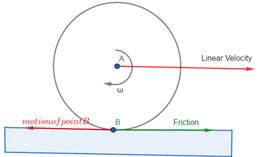A wheel of radius 20 cm is pushed to move it on a rough horizontal surface. It is found to move through a distance of 60 cm on the road during the time it completes one revolution about the center. Assume that the linear and the angular accelerations are uniform. The frictional force acting on the wheel by the surface is

Friction is always acted in opposite direction of motion.
The body is rotating in a clockwise direction. So, when the point B touches the ground, it appears to be moving in a direction antiparallel to the direction of motion. Hence, the ground tries to restrict this motion and applies friction in the opposite direction of motion of the point B. i.e. the direction of actual motion.
1